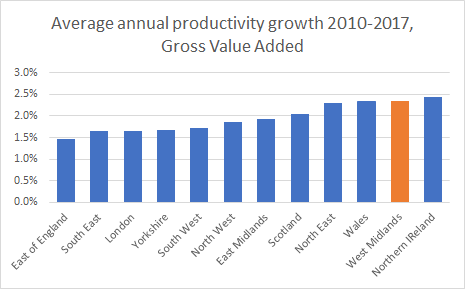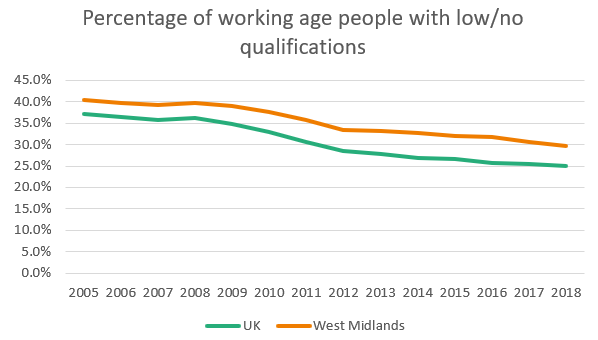REGIONAL ANALYSIS: West Midlands
Article
This analysis was handed out at our event Economic Justice for the West Midlands. The event was the West Midlands instalment in a UK-wide series of public meetings held by the IPPR Centre for Economic Justice.
Decline in manufacturing - Manufacturing jobs in the West Midlands have fallen by over 230,000 over the past 20 years, moving from 1 in 5 workers in 1999 to 1 in 10 workers today. This reflects a wider decline in UK manufacturing – but the fall in the West Midlands was particularly large, with 1 in 6 manufacturing job losses in the UK being accounted for in the West Midlands over this period.1

Source: IPPR analysis of workforce by industry (SIC 2007) (ONS)
Despite this, the value of goods exported per working age person is the highest of anywhere in the UK at over £9,000.2

Source: IPPR analysis using Regional and sub-regional productivity in the UK (ONS)
This will partially explain the region’s above average pay growth, which has risen by 2.1% a year on average since 2010, slightly above the UK average. Despite promising growth, IPPR analysis estimates that 27% of jobs in the West Midlands are paid less than the Real Living Wage, set at £9 an hour outside of London.
Qualifications - The West Midlands has the highest proportion of people with low or no qualifications of any region or nation. In 2018, 3 in 10 had low or no qualifications in the West Midlands compared to 2 in 10 in the South East, the best-performing region.
Despite improvements over time, the gap has widened with the rest of the UK. In 2005, working age people in the West Midlands were 9% more likely to have no or low qualifications than working age people across the UK, compared to being 18% more likely in 2018.

Source: IPPR analysis using Annual Population Survey (ONS). Low/no qualifications defined as less than NVQ L2
This suggests that workers in the West Midlands will be less able to access higher skilled and better paid jobs than the average worker in the UK and that this situation may be worsening over time.
References
1. IPPR analysis using Workforce jobs by industry (SIC 2007) (ONS)
2. IPPR analysis using UK imports and exports by region (UKTradeInfo) and population estimates by age (ONS)
Related items

Rule of the market: How to lower UK borrowing costs
The UK is paying a premium on its borrowing costs that ‘economic fundamentals’, such as the sustainability of its public finances, cannot fully explain.
Restoring security: Understanding the effects of removing the two-child limit across the UK
The government’s decision to lift the two-child limit marks one of the most significant changes to the social security system in a decade.
Building a healthier, wealthier Britain: Launching the IPPR Centre for Health and Prosperity
Following the success of our Commission on Health and Prosperity, IPPR is excited to launch the Centre for Health and Prosperity.